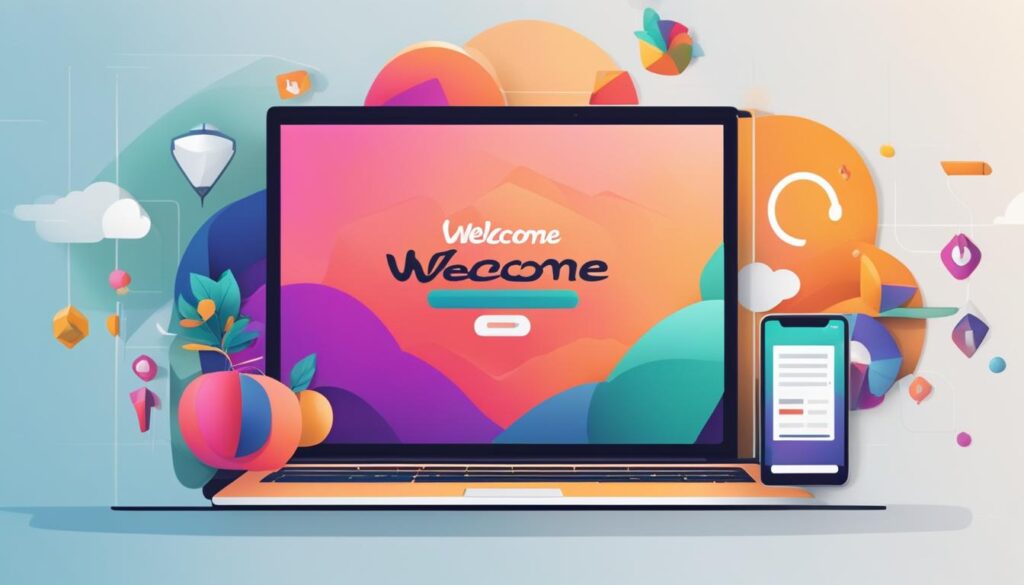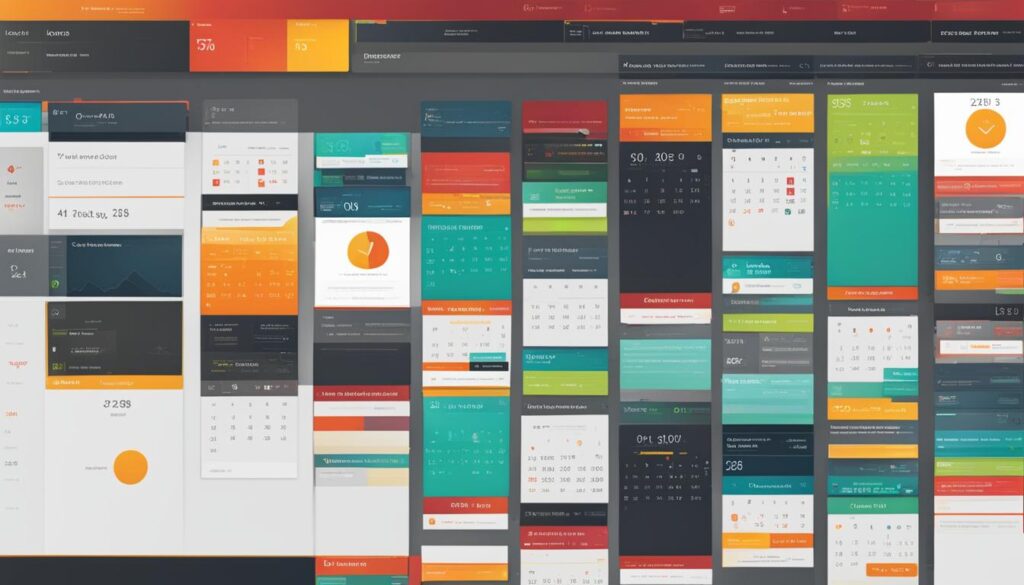Crafting a great online course structure is like putting together a sandwich – an analogy that might seem unconventional at first, but stay with us; this analogy packs a flavorful punch! Imagine your course content as the delicious filling, rich in flavor and substance. Now, think of the course structure as the bread that holds it all together. Just as a limp, soggy piece of bread can ruin the most delicious ingredients, if you toss everything haphazardly, you might end up with a poorly structured online course that leaves learners feeling like they’ve bitten into a virtual indigestible mayhem sandwich. However, by following the right course creation recipe, your online course can become the succulent, well-structured sandwich of learning, with each layer enhancing the overall experience, much like a perfectly assembled gourmet sandwich.
Key Takeaways:
- Web design plays a crucial role in optimizing the success of an online course.
- A well-structured online course enhances the learning experience for students.
- Using the right course creation techniques can ensure a cohesive and engaging learning journey.
- Web design should prioritize learner-centered language and personalized learning paths.
- Implementing technical SEO best practices can improve search engine rankings and attract more students.
5 Best Practices To Optimize Your Online Course Structure
We’ve researched and analyzed dozens of educational sources and consulted with course design experts to distill the most effective strategies for crafting an exceptional online course structure. These best practices are universally applicable, spanning across various industries and online businesses, so online learning couldn’t be an exemption. Whether you’re an entrepreneur developing online courses to educate your workforce, clients, or stakeholders, or you’re an individual, whether a first-time or a seasoned course creator, passionate about sharing your knowledge, these guidelines hold true for everyone.
1. Incorporate Learner-Centered Language
Using learner-centered language is essential in creating an engaging and inclusive learning experience. Make sure to align your course content with the diverse needs and preferences of your students. Encourage their active participation, autonomy, and align the language used with their motivations and goals.
2. Start with a Welcome Module
The welcome module serves as the introduction to your online course. It is a chance to get your learners excited and prepared for the course. Clearly outline the main topic, subtopics, course objectives, learning activities, and the course workflow. Additionally, building a sense of community can be achieved by introducing students to the instructor and encouraging interaction among learners.
3. Set a Clear Course Duration
Clearly communicate the duration of your course to manage your learners’ expectations. Structure your course into concise segments that align with typical attention spans, with each segment lasting no longer than 30 minutes. This approach ensures that learners can engage effectively and optimize their understanding and retention of the course material.
4. Create Personalized Learning Paths
Empower your learners by offering personalized learning paths tailored to their preferences and abilities. Design unique learning quests that allow learners to choose their own learning adventures. By providing options and allowing learners to explore topics that resonate with them, you enhance their engagement and enjoyment of the learning journey.
5. Create a Consistent Design and Course Layout
Maintaining a consistent design and course layout enhances the overall learning experience. Use a style guide to establish a cohesive visual identity for your course, including colors, buttons, icons, images, and typography. Consistency in design ensures that learners can easily navigate and understand the course material, resulting in increased engagement and retention.
| Benefits | Online Course Structure Best Practices |
|---|---|
| Engaging and Inclusive Learning Experience | Incorporate learner-centered language Start with a welcome module |
| Enhanced Comprehension and Retention | Set a clear course duration Create personalized learning paths |
| Improved Navigation and User Experience | Create a consistent design and course layout |
Use Learner-Centered Language
Incorporate learner-centered language into the structure and content of your online course syllabus to enhance the overall learning experience for your students. By prioritizing the use of learner-centered language, we can create more engaging and inclusive course materials and a learning environment that caters to the diverse needs and preferences of our students.
This involves using language that emphasizes their active role in the learning process, encourages their autonomy, and aligns with their motivations and goals.
When designing your course objectives, expectations, assessment criteria, feedback mechanisms, resources, and communication channels, keep in mind the importance of using learner-centered language. By doing so, you can foster a sense of ownership and empowerment among your students.
| Learner-Centered Language | Instructors’ Language |
|---|---|
| Choose a topic that interests you | We will cover the following topics |
| Share your thoughts in the discussion forum | Participation in the discussion forum is required |
| Explore additional resources based on your learning style | Here are some additional resources for you to review |
| Reflect on your learning progress and set personal goals | We will assess your understanding through quizzes and exams |
Benefits of Using Learner-Centered Language
- Enhanced engagement: Learners become more actively involved in the learning process when they feel their voice is valued.
- Increased motivation: Learner-centered language helps students connect their personal goals and aspirations with the course content, leading to higher levels of motivation.
- Improved understanding: By using language that aligns with learners’ existing knowledge and experiences, new concepts become more relatable and easier to comprehend.
- Greater inclusivity: Diverse learners have different needs and preferences. Using learner-centered language helps create an inclusive environment that acknowledges and respects these differences.
- Enhanced retention: When learners feel a sense of ownership in their learning journey, they are more likely to retain and apply the knowledge gained.
By implementing learner-centered language, we can create a more engaging and interactive online learning experience that caters to the diverse needs and preferences of our students while promoting their active involvement in the learning process.

Start with a Welcome Module
We believe that starting your online course with a welcome module is essential for setting the stage and engaging your learners right from the beginning. This module serves as the online course introduction, providing a comprehensive overview of what the course is all about. It’s an opportunity to capture your students’ attention and generate excitement about the learning journey that lies ahead.
The welcome module should include:
- Course outline: Provide a clear and concise overview of the course structure, highlighting the main topics and subtopics that will be covered. This gives learners a roadmap of what to expect and helps them mentally prepare for the course.
- Learning activity: Incorporate an interactive learning activity to encourage active participation and immediate engagement. This can be a brief quiz, a reflective exercise, or a thought-provoking question related to the course content.
Setting the Course Idea and End Goal
“The future belongs to those who believe in the beauty of their dreams.” – Eleanor Roosevelt
Every online course has an underlying course idea, a central concept that drives the entire learning experience. In the welcome module, clearly articulate this idea and highlight the end goal that learners will be working towards. By doing so, you provide a sense of purpose and motivation, inspiring your students to invest their time and effort into the course.
Course Workflow and Sense of Community
- Course workflow: Break down the course workflow, explaining how the course will progress and what students can expect in terms of assignments, deadlines, and assessments. Providing this information upfront helps students plan their time effectively and stay on track throughout the course.
- Sense of community: Emphasize the importance of building a sense of community among the learners and instructor. Encourage students to introduce themselves and participate in discussion forums or virtual meet-ups. This fosters a supportive and collaborative learning environment and enhances the overall learning experience.
Remember, the welcome module is the first impression your students will have of your course, so make it engaging, informative, and visually appealing. It sets the tone for the rest of the course and lays the foundation for a successful learning journey.

Set a Clear Course Duration
When structuring your online course outline, the course duration is a crucial factor that needs to be clearly communicated right from the start. The duration plays a pivotal role in ensuring an effective learning experience for your students. To maximize engagement and comprehension, it is essential to structure your course in a way that delivers content in easily digestible chunks.
One key guideline for setting the course duration is to arrange your modules into concise segments, with each segment lasting no longer than 30 minutes. By breaking down your course into these bite-sized segments, you align your content delivery with the typical attention spans of your learners.
This approach not only helps to capture and maintain the attention of your students but also allows for better retention of the information being presented. By organizing your course in this manner, you create a learning environment that promotes measurable student learning and ensures achievable expectations for both you as the instructor and your students.
By breaking down the course duration into concise segments, you enable your students to progress through the material at a steady pace, without feeling overwhelmed. This approach also allows for easier navigation and review of specific topics as needed, making it a user-friendly experience.

Benefits of Setting a Clear Course Duration:
- Maximizes student engagement
- Enhances comprehension and retention
- Aligns with attention spans
- Promotes measurable student learning
- Sets achievable expectations
To put it simply, a clear course duration with concise segments is the key to creating an optimal learning experience that fosters success for both you and your students.
| Key Considerations | Benefits |
|---|---|
| Structured course outline | Clear roadmap for students |
| Concise segments | Maximized student engagement |
| Aligned with attention spans | Enhanced comprehension and retention |
| Measurable student learning | Evidence of progress and achievement |
| Achievable expectations | Reduced student overwhelm |
Create Personalized Learning Paths
In today’s digital age, personalized learning has become a key factor in delivering effective and engaging online courses. Gone are the days of one-size-fits-all education; learners now expect customized learning experiences that cater to their unique preferences and abilities. By creating personalized learning paths, you can transform your online course into a captivating choose-your-own-adventure story, where learners have the freedom to explore and make choices that align with their interests and goals.
Personalized learning paths allow learners to embark on unique learning quests, where they can choose their own path, pick the challenges they’re most excited about, and acquire skills that are meaningful to them. This level of customization empowers learners and enhances their motivation and engagement throughout the course.
Imagine your online course as a sprawling landscape, filled with diverse learning opportunities. With personalized learning paths, you can guide your learners through this landscape, ensuring they engage in content that is relevant to their interests and abilities. Just like intrepid explorers, your learners can navigate through the course, discovering engaging and enjoyable content that sparks their curiosity and fuels their passion for learning.
Personalized learning paths are not only beneficial to learners but also to course creators. By understanding learner preferences and abilities, you can design learning paths that align with their needs and provide targeted support. This individualized approach fosters a sense of connection and builds a stronger rapport with your learners, leading to increased satisfaction and retention rates.
“Education is not the filling of a pail, but the lighting of a fire.” – William Butler Yeats
The Benefits of Personalized Learning Paths:
- Enhanced learner engagement and motivation
- Increased learner satisfaction and retention
- Improved learning outcomes and skill acquisition
- Greater autonomy and empowerment for learners
- Catering to diverse learner preferences and abilities
Designing personalized learning paths requires a deep understanding of your learners and their needs. Start by gathering information about their interests, prior knowledge, and learning goals. Use this information to create tailored learning experiences that guide learners through a series of engaging and relevant activities. Ensure that each pathway offers unique learning quests and allows learners to explore topics that align with their personal interests, making the learning experience enjoyable and meaningful.
Remember, personalized learning paths are not about segregating learners, but rather about providing customized support and options that enhance their learning journey. By embracing personalized learning strategies in your online courses, you can create an educational experience that truly caters to the individual needs and aspirations of your learners.

| Benefits of Personalized Learning Paths | Examples |
|---|---|
| Enhanced learner engagement and motivation | Interactive quizzes and gamified activities that captivate learners’ attention |
| Increased learner satisfaction and retention | Providing a sense of accomplishment and recognition for completing personalized learning quests |
| Improved learning outcomes and skill acquisition | Targeted resources and activities that address specific learner needs and goals |
| Greater autonomy and empowerment for learners | Opportunities for learners to make choices and take ownership of their learning journey |
| Catering to diverse learner preferences and abilities | Offering multiple pathways for learners to explore based on their individual interests and capabilities |
Create a Consistent Design and Course Layout
Consistency is key when it comes to designing your online course. A consistent design and course layout not only improve the overall learning experience but also make it easier for learners to follow and understand the course content. By maintaining a concise lesson plan and creating a cohesive look and feel, you can increase engagement and retention among your students.
Why Consistency Matters
Consistency in your course design and layout creates a sense of familiarity and helps learners navigate through the material more efficiently. When the visual elements and structure remain consistent, students can focus on the content without being distracted by inconsistencies or confusing layouts. This promotes a seamless learning experience and enhances their comprehension and retention of the course material.
“Consistency in design is not about making all elements look the same. It’s about making elements feel like they belong together, creating a harmonious and intuitive learning environment.” – Course Design Expert
Creating a Style Guide
One effective way to achieve a consistent design and course layout is by creating a style guide at the beginning of your eLearning development process. A style guide is a step-by-step guide that outlines all the visual elements you plan to use, such as colors, buttons, icons, images, and typography. It sets the visual tone for your course, ensuring a cohesive look and feel.
By following the guidelines set in your style guide, you can maintain consistency throughout your course. This includes using the same color scheme, typography, and visual elements across all modules and lessons. Consistency in design creates a sense of professionalism and helps establish your course’s brand identity.
The Benefits of a Consistent Design
A consistent design and course layout offer several benefits that enhance the learning experience for your students. Here are some key advantages:
- Improved Engagement: Consistency in design makes your course more visually appealing and engaging, capturing learners’ attention and encouraging active participation.
- Enhanced Retention: When learners can easily follow and understand the course material, they are more likely to retain the information in the long term.
- Streamlined Navigation: A consistent course layout allows learners to navigate through modules and lessons effortlessly, reducing confusion and frustration.
- Professional Image: A cohesive and visually pleasing design gives your course a professional and polished image, instilling confidence in your students.

Bringing It All Together
Consistency in design and course layout is a fundamental aspect of creating an effective online course. By implementing a concise lesson plan, maintaining a cohesive look and feel, and adhering to your style guide, you can significantly improve the learning experience for your students. The result is increased engagement, better comprehension, and higher retention rates. So, take the time to design your online course with consistency in mind, and watch your learners thrive in a visually appealing and well-structured learning environment.
Implement Technical SEO Best Practices
The foundation for technical SEO is having a solid website architecture. One cannot simply publish a random collection of pages and posts. An SEO-friendly site architecture will guide users throughout your site and make it easy for search engines to crawl and index your pages.
Once you have the right architecture in place, it’s time to perform a technical or SEO audit. This will help you identify any issues that might be hindering your website’s SEO performance, such as status code errors, broken links, duplicated title tags, and suboptimal meta descriptions. By fixing these issues and optimizing your website’s technical elements, you can improve your search engine rankings and enhance the user experience.
To ensure your website is easily crawlable and indexable by search engines, it’s important to optimize your robot.txt file. This file tells search engines which pages of your website to crawl and which pages to ignore. By optimizing the robot.txt file, you can ensure that search engines are properly indexing your site and not wasting resources on irrelevant pages.
One common issue that can negatively impact your SEO is having duplicate title tags and meta descriptions. These elements play a crucial role in telling search engines what your web pages are about. Duplicate title tags and meta descriptions can confuse search engines and affect your visibility in search results. Performing a comprehensive website content audit will help you identify and resolve any instances of duplicate title tags and meta descriptions, ensuring that each page has unique and optimized metadata.
Another important aspect of technical SEO is identifying and fixing broken links. Broken links not only frustrate users but can also harm your SEO efforts. Search engines value websites that provide a seamless browsing experience, and broken links can negatively impact your website’s reputation. Regularly auditing your website for broken links and promptly fixing them will improve both user experience and search engine rankings.
Additionally, submitting an XML sitemap to search engines can help them better understand the structure of your website and index your pages more effectively. An XML sitemap serves as a roadmap for search engine crawlers, guiding them to your most important content and ensuring complete indexing of your site.
To summarize, implementing technical SEO best practices is vital for optimizing your website’s performance in search engine rankings. By focusing on solid website architecture, optimizing for crawlability and indexability, resolving status code errors and broken links, optimizing title tags and meta descriptions, conducting a website content audit, and submitting an XML sitemap, you can enhance your website’s visibility and improve the user experience.
Conclusion
Implementing effective SEO strategies in web design is essential for optimizing online courses, driving traffic to your training portal, and boosting your search engine rankings. By incorporating learner-centered language, creating a welcoming module, setting clear course durations, offering personalized learning paths, maintaining a consistent design and layout, and implementing technical SEO best practices, you can enhance the overall learning experience for your students and achieve greater success in the e-learning industry.
An SEO-optimized training portal not only attracts more visitors but also increases enrollment in your online courses. By optimizing your website with relevant keywords, meta tags, and high-quality content, you can generate more organic traffic and reach a wider audience. Additionally, using learner-centric language and providing personalized learning paths empower your students, creating a tailored and engaging learning experience.
Don’t underestimate the power of SEO in web design for online courses. By following these best practices, you can drive website traffic, enhance student engagement, and achieve higher search engine rankings. Take advantage of SEO strategies and optimize your training portal today to maximize the success of your online courses.
FAQ
What is the purpose of the welcome module in an online course?
The welcome module introduces the course to students, providing an overview of the main topic and subtopics, the course idea, the end goal, what they’ll learn, and why it’s worth their time. It also explains how the course will work, including assignment deadlines and grading policies. Additionally, the welcome module helps build a sense of community among students and the instructor.
Why is it important to set a clear course duration?
Setting a clear course duration is crucial for an effective learning experience. It helps students plan their time and ensures that the content is delivered in easily digestible chunks. Ideally, course modules should be arranged into concise segments, with each lasting no longer than 30 minutes. This approach aligns with the typical attention spans of learners and maximizes engagement and comprehension.
How can personalized learning paths enhance the online course experience?
Personalized learning paths empower learners to customize their learning journey according to their interests, preferences, and abilities. By offering choices and allowing learners to pick the challenges they’re most excited about, personalized learning paths create a more engaging and enjoyable exploration. This customization enhances learner motivation and helps them acquire skills in a way that is meaningful to them.
Why is consistency in design and course layout important for an online course?
Consistency in design and course layout improves the overall learning experience. When a course has a concise structure and maintains consistency in its visuals and organization, learners can easily follow and understand the course material. This not only makes learning more enjoyable but also increases engagement and retention. Creating a style guide at the beginning of the course development process helps ensure a cohesive look and feel.
How can technical SEO best practices improve the performance of an online course website?
Implementing technical SEO best practices improves the website architecture and enhances the user experience. A solid website architecture guides users throughout the site and makes it easier for search engines to crawl and index pages. Performing a technical SEO audit helps identify any issues that might hinder SEO performance, such as broken links, duplicated title tags, and suboptimal meta descriptions. By addressing these issues and optimizing technical elements, the website’s search engine rankings and overall performance can be improved.

Leave a Reply